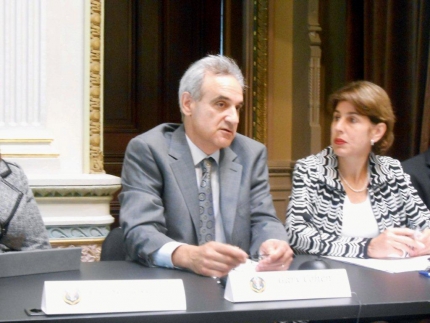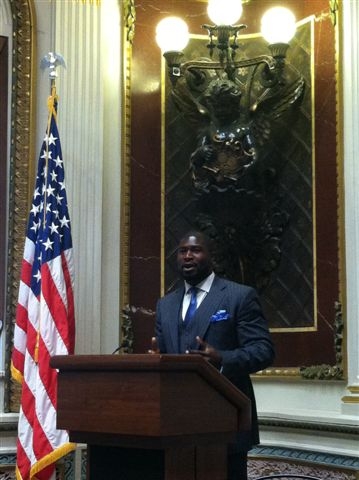Council on Environmental Quality Blog
Growing Our Economy Through the Great Outdoors
Posted by on July 31, 2012 at 8:55 AM EDTIt comes as no surprise that all living things require clean land, air and water. Does the U.S. economy require the same? A new report from the Outdoor Industry Association says, yes! According to the report, recreation in the United States supports 6.1 million jobs and drives $646 billion a year in direct consumer spending on recreational gear and travel. Even during these challenging economic times, the outdoor industry has been growing at a steady rate of 5 percent annually.
President Obama has proposed a $450 million investment in the Land and Water Conservation Fund (LWCF) for fiscal year 2013. The LWCF is a critical tool for protecting our forests, parks, rivers, open space and local sports fields. By using revenues from oil and gas drilling to invest in Federal, state and local conservation efforts, the LWCF has been used over the last 50 years to provide recreational opportunities in nearly every county in the Nation. Congress should follow the President’s lead by funding the LWCF, which will protect and enhance the local and state parks enjoyed by fly fishing enthusiasts around the country.
At the American Fly Fishing Trade Association, we understand the importance of protecting our public lands and fostering the economic contributions of outdoor enthusiasts. Manufacturers and retailers of fly-fishing products are not looking for a handout. What we envision is our Nation’s leaders working together to protect the public lands where citizens can use our products and ensure future generations have the same opportunities to recreate as we do today. We should all be able to agree that protecting the public’s access to the outdoors now and for future generations is not only common sense, but also the ideal job creator.
Ben Bulis is the President of the American Fly Fishing Trade Association
Learn more about Energy and EnvironmentAdvancing National Security Through Energy Security
Posted by on July 27, 2012 at 10:56 AM EDTRecently, I had the great privilege to watch our highly skilled sailors doing what they do best, and to witness the U.S. Navy's most sophisticated air and sea platforms perform complex operations using advanced biofuel and energy efficient technologies.
Last week during RIMPAC, the largest maritime exercise in the world, the U.S. Navy successfully demonstrated the Great Green Fleet, a Carrier Strike Group's aircraft and surface ships, on advanced biofuel to test the fuel's performance while conducting operations, including: fueling helicopters and jets from the deck of a nuclear-powered carrier; completing arrested landings of aircraft onto a carrier, the first ever using biofuels; refueling a destroyer while underway; and air-to-air refueling.
The demonstrations confirmed that advanced biofuels can be integrated seamlessly for the user and perform the same as traditional fossil fuel. The demonstration also showcased energy efficiency technology that increases combat capability.
The Navy is pursuing alternatives because the nation’s reliance on foreign oil is a significant and well-recognized military vulnerability. The ability to use fuels other than petroleum is critical to our energy security because it will increase our flexibility and reduce the services' vulnerability to rapid and unforeseen changes in the price of oil. A $1 change in the price of a barrel of oil, for example, results in an approximately $30 million change in the Navy budget. This is why the Navy will only purchase operational quantities of biofuel blends when they are competitive with petroleum, period. We simply cannot afford to do it otherwise and will not do it.
Joining me at the demonstration was Chief of Naval Operations Jonathan Greenert, and the commanders of U.S. Pacific Fleet and U.S. 3rd Fleet. Their participation signaled to the Navy and the nation the Navy’s commitment to pursuing alternatives to imported fossil fuels because we believe it is critical to our national security.
A viable advanced biofuels market can inject competition into the liquid fuel market, which could drive down the cost of liquid fuels and dampen price volatility. We recently pushed more competition into the shipbuilding industry, which allowed the Navy to bring down the cost of our ships. We can do the same for the fuel we purchase to power those ships and other platforms.
The Navy has always led in energy transformations, moving from wind to coal, coal to oil, and then pioneering the use of nuclear power. The Great Green Fleet was named in honor of the Great White Fleet that circled the globe beginning in 1907 and introduced America as a global power. It comprised the most advanced ships of its time; battleships made from steel and powered by steam, and represented America’s greatness and ingenuity. The Great Green Fleet demonstration continues our long tradition of energy transformation by powering the Fleet with alternative fuels.
Ray Mabus is the United States Secretary of the Navy
Learn more about Energy and EnvironmentPromoting Sustainable Health Care
Posted by on July 24, 2012 at 3:26 PM EDTImagine energy efficient hospitals that save money on energy bills to use for critical patient care, and that promote renewable energy as a community health and resilience strategy. Imagine hospitals that create healthy food environments to help address the epidemic of obesity and diabetes in our country. Imagine hospitals that lead society in reducing toxic chemical exposures , and that are reducing their waste, saving money and improving patient care at the same time. Imagine a health care system that redefines “community benefit” to include improving the living conditions of communities that hospitals serve, and focusing on the prevention of disease through environmental health in addition to treatment. Imagine a health care system that makes up over 20 percent of the U.S. economy and becomes the driving force for safer products, cleaner energy, and healthier communities.
This vision is what the Healthier Hospital Initiative is bringing to reality today and is proud to share with the Obama Administration at the White House event on Health Care and Sustainability. We have created a roadmap for hospitals to embed sustainability into their core business model and are providing technical assistance to offer every hospital in America the chance to participate for free. Health Care Without Harm has joined with our sister organization Practice Greenhealth, The Center for Health Design and 11 of the largest hospital systems in America to create the Healthier Hospital Initiative and drive this movement in health care for healthier hospitals. We already have the participation of more than 600 hospitals and we aim to recruit 2,000 overall and track the progress of the sector in achieving our goals.
Learn more about Energy and EnvironmentMaking Plans for GreenGov 2012: Leading by Example
Posted by on July 24, 2012 at 10:45 AM EDTThe third annual GreenGov Symposium is taking place in Washington, D.C. September 24 - 26, 2012. Co-hosted by the Council on Environmental Quality and the Association of Climate Change Officers (ACCO), the Symposium will bring sustainability leaders and newcomers in the federal, state, and local government, academic, non-profit and private sectors together to learn from each other, share ideas, and help develop innovative solutions to our energy and sustainability challenges. By design, the Symposium helps the Federal Community save energy, save money, and address our sustainability goals and targets under Executive Order 13514: Federal Leadership in Environmental, Energy, and Economic Performance.
Now, you can take a look at the preliminary agenda for the Symposium on http://www.greengov2012.com/program-agenda.html. With ten tracks over two days, the Symposium will have more than 50 informative sessions, including panel discussions with leading experts, best practice case studies, and new concept, 101-education sessions. And, we are ensuring that some sessions will be webcast to allow those who cannot attend to share in the GreenGov experience. This year we are also hosting post-conference workshops and meetings on September 26, 2012, to allow for additional discussion and training related to sustainability.
The Symposium is unlike any other annual gathering, designed specifically for the benefit of government employees who are dedicated to helping their agencies and the Federal government lead by example in meeting sustainability targets laid forth by the President. The work accomplished during the Symposium is beneficial to all levels of government, with initiatives targeting better management and fewer taxpayer dollars spent on government operations.
Learn more about Energy and EnvironmentPromoting Sustainability Through Sports
Posted by on July 19, 2012 at 12:46 PM EDTI am honored to speak today as part of a White House Event on Sports and Sustainability. As a professional athlete and an advocate for clean, healthy communities, it is a privilege to speak on behalf of athletes and sports arenas across the country who are working to promote a sustainable future.
In 2008, I established the Ovie Mughelli Foundation to help educate children about how their environment affects them. Through the foundation, I have had the opportunity to work with leaders across sectors who share the goal of educating millions of Americans about promoting sustainability in today's world. We also share the Obama Administration’s commitment to encouraging measures that save energy, reduce pollution, and foster healthy and successful living environments.
A major part of my efforts has been to leverage the opportunities I’ve gained as a professional football player to encourage not only adults but also young people to take action at home. With the promotion of practical lifestyle changes within our everyday communities, we have encouraged people to champion actions that keep their communities healthy, including through fun activities that combine sports with environmental education. Most importantly, the Mughelli team strives to foster leadership in the next generation to build a green movement that addresses their needs and concerns.
It’s an honor to participate in this White House event – I plan to continue to work with others in the sports community and outside of it to raise awareness about the steps we can all take to provide for a healthy and sustainable future.
Ovie Mughelli is a National Football League Pro Bowl fullback and founder of the Ovie Mughelli Foundation, a nonprofit organization that educates children about the environment
Learn more about Energy and EnvironmentReducing Asthma Disparities
Posted by on July 5, 2012 at 4:39 PM EDTAs a primary care pediatrician and leader of the Community Asthma Prevention Program of the Children’s Hospital of Philadelphia, I am very excited about the Coordinated Federal Action Plan the Obama Administration recently announced to reduce asthma disparities. For years there have been a number of disparate efforts from various federal agencies to address asthma disparities; yet the gap in asthma-related emergency room visits, hospitalizations and deaths still exist. Asthma is a disease that is impacted by a host of environmental, health and social factors. Therefore it’s no surprise that efforts made in a singular fashion have not worked in the past. This Coordinated Federal Action Plan represents the coming together of 16 federal agencies to use their collective strengths to collaboratively and systematically reduce, and someday eliminate, asthma disparities.
This plan recognizes the importance of the community’s involvement in efforts to reach disparate populations and the importance of collaboration among healthcare providers, community agencies, and social support systems. The following two strategies resonate with my experience in taking care of children with asthma:
- The standardization of training and certification of Community Health Workers (CHW) and utilization of CHW’s in care of at-risk asthmatics
The Community Health Worker is often the unsung hero in the frontline effort to intervene in the disproportionate burden of asthma on disadvantaged communities. These highly trained lay health educators are effective in working together with families to increase self-management skills and to remove asthma triggers as well as provide care coordination services. CHW’s are often the glue that connects caregivers to the healthcare system, community resources and social support systems and a key driver in community efforts to reduce asthma disparities. Given their important role in working with the most vulnerable populations suffering from the burden asthma places on their lives, standardization of curriculum and certification of CHW’s is a necessary step in providing wrap around asthma care to reduce asthma disparities and asthma costs.
- Promoting collaboration across all systems that serve children with asthma including health care, housing, schools and childcare settings
While disseminating best practices in implementing asthma guidelines is a step in improving overall asthma health outcomes, it is essential that the asthma care plan accompanies the child where they live, learn and play. Strategies toward this goal include: creating communication channels via federal interagency and private partnerships to provide comprehensive services to the people most affected by asthma; sharing data (including asthma care plans) between health care and school/childcare systems; and equipping federally qualified health centers and hospitals who serve disadvantaged populations to implement best practices.
The Coordinated Federal Action Plan provides guidance for approaching asthma disparities in a holistic fashion recognizing that patients live in the “real” world where their housing, health and education are all interconnected. Using all resources available and intervening in an integrated, collaborative manner will give us the greatest chance for finally closing the gap on asthma disparities.
Tyra Bryant-Stephens is Director and Founder of the Community Asthma Prevention Program at the Children’s Hospital of Philadelphia, and Clinical Associate Professor of Pediatrics at the University of Pennsylvania School of Medicine
Learn more about Energy and Environment
- &lsaquo previous
- …
- 11
- 12
- 13
- 14
- 15
- 16
- 17
- 18
- 19
- …
- next &rsaquo
White House Blogs
- The White House Blog
- Middle Class Task Force
- Council of Economic Advisers
- Council on Environmental Quality
- Council on Women and Girls
- Office of Intergovernmental Affairs
- Office of Management and Budget
- Office of Public Engagement
- Office of Science & Tech Policy
- Office of Urban Affairs
- Open Government
- Faith and Neighborhood Partnerships
- Social Innovation and Civic Participation
- US Trade Representative
- Office National Drug Control Policy
categories
- AIDS Policy
- Alaska
- Blueprint for an America Built to Last
- Budget
- Civil Rights
- Defense
- Disabilities
- Economy
- Education
- Energy and Environment
- Equal Pay
- Ethics
- Faith Based
- Fiscal Responsibility
- Foreign Policy
- Grab Bag
- Health Care
- Homeland Security
- Immigration
- Innovation Fellows
- Inside the White House
- Middle Class Security
- Open Government
- Poverty
- Rural
- Seniors and Social Security
- Service
- Social Innovation
- State of the Union
- Taxes
- Technology
- Urban Policy
- Veterans
- Violence Prevention
- White House Internships
- Women
- Working Families
- Additional Issues




